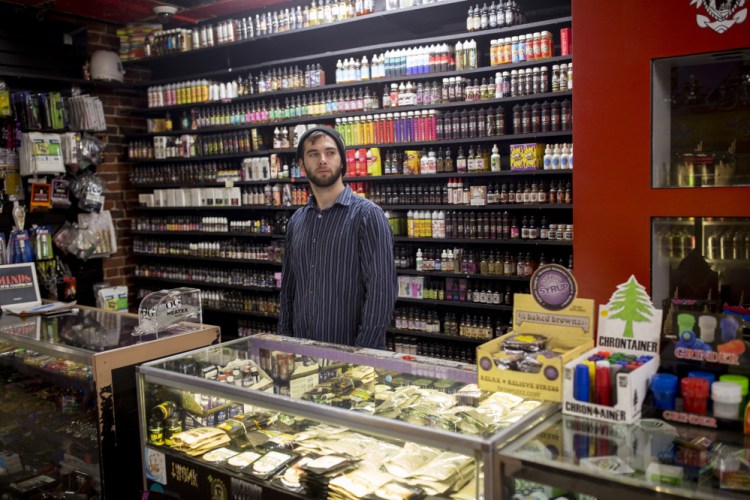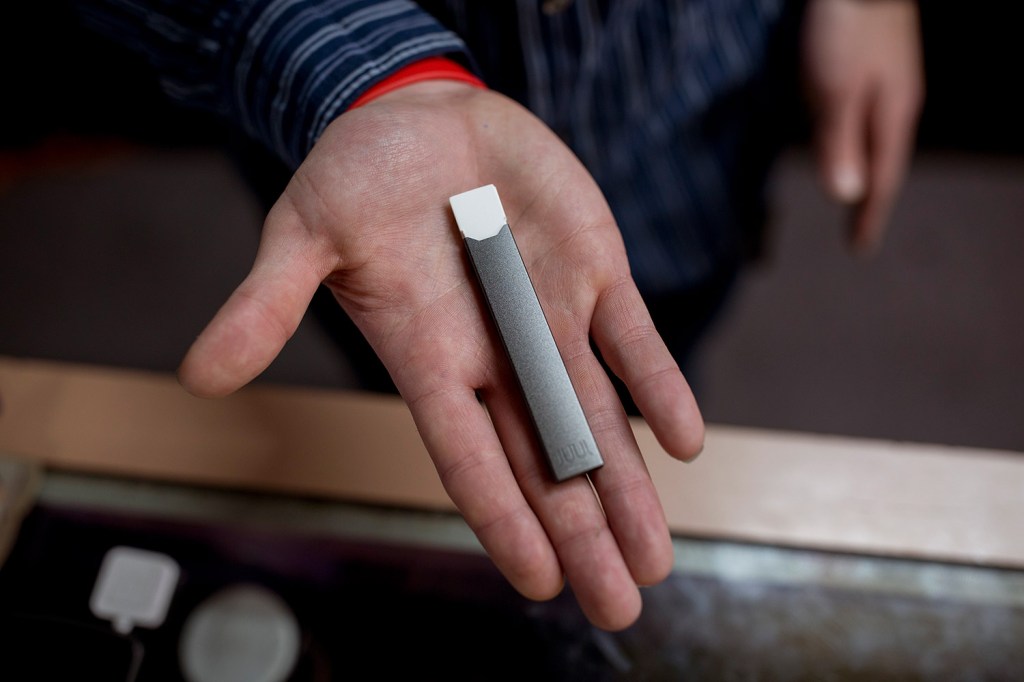Vaping is a growing substance abuse concern at high schools around the nation, and students in Maine are more likely to have tried an e-cigarette or vaporizer to inhale an aerosol that can contain nicotine, flavoring and other additives that can include THC, the active ingredient in marijuana.
Cape Elizabeth High School Principal Jeffrey Shedd sent a warning to students and parents in October after students had been caught vaping five days in a row. Some of those students told school officials they were addicted and couldn’t stop.
It “was the first time we had to send out something like that,” Shedd said.
Greely High School in Cumberland followed with a similar notice in November about “multiple incidents.” And this week, Yarmouth’s superintendent sent an email to parents about an increase in students vaping, both at the high school and at the middle school.
Around 15 percent of Maine high school students say they had used an electronic vapor product within the past 30 days, according to the 2017 Maine Integrated Youth Health Survey conducted in February 2017 and released last month. Nationwide, about 11 percent of high schoolers said they have vaped, according to a survey released in June by the U.S. Centers for Disease Control and Prevention.
The Maine survey indicates that usage dropped from the 2015 survey, when about 18 percent of students said they had used a vaporizer. However, school officials and students said they have seen a noticeable increase since the 2015 survey, and especially in recent weeks and months.
The easily hidden devices are seen as harmless by some teenagers, but can lead to nicotine addiction and could impact students’ health in ways that are not yet fully understood. Students have been caught vaping in bathrooms, and are even doing it in their classrooms.
Electronic vapor products, also known as vaporizers, are similar to e-cigarettes. Vaporizers have a battery that heats a cartridge, tank or pod of liquid, which often contains nicotine and sweet and fruity flavoring, until an aerosol is produced. The nicotine in the vapor causes the brain to release adrenaline, which leads to a short head rush or buzz.
Vaporizers also can deliver THC, the active ingredient in marijuana, but that appears to be much less common in schools, where officials are more worried that students are becoming addicted to nicotine and at risk of transitioning to cigarettes.
Shedd, who has been Cape Elizabeth High School’s principal for 17 years, said vaping has become popular among high school students within the last two or three years. So far this school year, there have been eight or nine students caught vaping. Most of them were juniors or seniors.
“It’s almost always the boy’s bathroom,” he said, “and occasionally in the boy’s locker room.”
Interim Cape Elizabeth Superintendent Howard Colter said that while he doesn’t believe a large number of students vape, “even a small number” is concerning.
“My impression is that this is a growing trend among some young people who think vaping is a better option than smoking,” Colter said, “because it doesn’t involve some of the health risks of smoking cigarettes.”
DEVICES EASY TO HIDE
Some of the vaporizers can appear “discreet-looking,” Colter said. They can be small and resemble everyday objects, such as pens, and students can use their laptops to charge the batteries in their devices while they sit in class. One of the most popular, and most inconspicuous, devices is sold by JUUL and resembles a slim, silver flash drive. This device costs $34.99 and includes a USB charger. When someone uses a JUUL device to vape, it is commonly referred to as ‘juuling,’ a new vaping trend that has gained traction at high schools across the country and in Maine.
The maker of the devices, JUUL Labs, provided a written statement to the Portland Press Herald saying its products are not intended for teens and are intended to help adults who want to quit smoking.
“JUUL Labs’ mission is to eliminate cigarettes by offering existing adult smokers with a better alternative to combustible cigarettes. JUUL is not intended for anyone else. No minor should be in possession of a JUUL. We strongly condemn the use of our product by minors, and it is in fact illegal to sell our product to minors,” the company said.
The manufacturers also said the sweet and fruity flavors are not intended to entice children, but are offered to “meet the preferences and needs of adult smokers.”
Cape school officials, meanwhile, are making additional efforts to check bathrooms for vaping so other students can feel comfortable using them for “their intended purpose,” Colter added.
Dan McKeone has been Greely’s principal for eight years and said school officials first became aware of vaping last year, but that incidents have gone up over the past few months. “It mostly occurs in the bathrooms, or anywhere it can be hidden,” he said.
South Portland Superintendent Ken Kunin said the vaping trend at South Portland High is consistent with what other school districts in Maine are finding.
“We’ve certainly seen an increase over the last several years,” Kunin said. “In the 2015-2016 school year, it really began to kick up a bit, but we’ve seen a greater increase in the last year. It’s worrisome to us.”
A big concern for school officials is that the industry is mostly unregulated. According to McKeone’s school notice, the U.S. Food and Drug Administration has passed regulations that will require ingredient labeling, but those regulations have not gone into effect yet. Right now, the ingredients in various vaping liquids may be a mystery to students who inhale them, if the students even bother to read the labels.
“Even though a lot of the products claim they don’t have nicotine, they are mislabeled,” said Lance Boucher, the Maine director of public policy for the American Lung Association. “(Vaping) products that claim to be nicotine-free have been shown to have nicotine in them.”
Studies are showing that teenagers who use these products transition into becoming regular users of tobacco. A study in this month’s Pediatrics, a peer-reviewed journal published by the American Academy of Pediatrics, concluded that e-cigarette use by high school students predicted future cigarette use.
ADDICTED AT SUSCEPTIBLE AGE
“They’re getting addicted to nicotine at a time in their lives when they’re brains are susceptible to addiction,” Boucher said.
E-cigarettes are now the most commonly used form of tobacco by youth in the country, according to the CDC website. The CDC says that many students who use the devices cite their belief they are less harmful than other tobacco products.
Even liquids free of nicotine may not be entirely without risk.
“The longitudinal data doesn’t exist that shows that there aren’t health risks associated with vaping,” he said. “Inhaling anything into your lungs is not safe and without harm.”
School officials say students caught with vaporizers are, at least in some cases, suspended from extracurricular activities and could be suspended from school, depending on the number of times a student has been caught. Schools also are referring offenders to a school substance abuse counselor or anti-substance abuse programs. They can potentially be referred to law enforcement, as well.
“If students are caught vaping, it’s (like) being caught smoking. It can even be (like being) caught with drug paraphernalia, because we know some of the cartridges being used contain THC,” Kunin said.
While prices for the vaporizers vary widely, Lee Anne Dodge, director of the SoPo Unite: All Ages, All In Drug-Free Community Coalition, a group consisting of substance abuse professionals, students, parents, and school stakeholders, noted that some vaping liquids are cheaper than cigarettes. Four liquid pods from JUUL, for instance, cost $15.99 altogether. Each pod contains as much nicotine as one pack of cigarettes and can last a week. The cheapest cigarettes go for $7 or $8 a pack, Dodge said.
Student members of the SoPo Unite Coalition have reported to coalition and school officials that students at the high school have vaped in their classrooms, as the devices can be so small and odorless that they are difficult to detect.
Students also have been selling vaping liquids in school, Dodge said, while other students have avoided going to the bathrooms because of students vaping in them. One student who had been caught vaping was inhaling the nicotine equivalent of one pack of cigarettes a day, she said.
Another concern is the sweet flavors the liquids come in, like mango or cotton candy, flavors may appeal to teenagers.
“Really, how many adults do you know that crave cotton candy?” Dodge said.
Although vaping products are considered tobacco products and cannot be legally sold to individuals under 18, some students acquire vaping products either online or from their peers. Beginning July 2018, the legal age goes to 21.
Aidan Schifano, a senior at South Portland High School and student member of the SoPo Unite Coalition, said some students have become addicted to vaping, to the detriment of their extracurricular and academic success.
“Some student athletes are ineligible to play because of grades or were suspended from fall teams,” he said. “(Vaping) consumes their time and they’re not as focused on school work or practice.”
Cara DeRose can be contacted at 7916363 or at:
cderose@pressherald.com
Send questions/comments to the editors.




Success. Please wait for the page to reload. If the page does not reload within 5 seconds, please refresh the page.
Enter your email and password to access comments.
Hi, to comment on stories you must . This profile is in addition to your subscription and website login.
Already have a commenting profile? .
Invalid username/password.
Please check your email to confirm and complete your registration.
Only subscribers are eligible to post comments. Please subscribe or login first for digital access. Here’s why.
Use the form below to reset your password. When you've submitted your account email, we will send an email with a reset code.